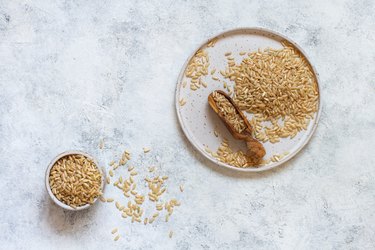
If rice is a staple in your diet, you're probably wondering if eating rice every day is a good idea. The short answer is: It depends on whom you ask. Some say that there are plenty of brown rice benefits that make it part of a healthy diet.
But people on other side of the argument say that although brown rice looks good on paper, it's not all it's cracked up to be. Of course, the best nutritional strategy is to vary your food intake so that you're eating lots of different types of foods over the course of the week. This ensures you're getting a wide variety of nutrients and meeting all of your needs.
Video of the Day
Video of the Day
Tip
Brown rice does provide important nutrients, like fiber, and is usually recommended over white rice. But the outer later of brown rice, called the bran, also contains anti-nutrients that block the absorption of certain minerals.
Brown Rice Nutrition Facts
You've probably heard the advice to choose brown rice, which is considered a whole grain, over white rice, which is labeled as a source of refined carbohydrates. And while that advice comes from a good place, it might not actually be that simple. According to the USDA, a cup of cooked brown rice contains:
- 238 calories
- 5 g protein
- 2 g fat
- 50 g carbohydrates
- 3 g fiber
- 76 mg magnesium
- 199 mg phosphorus
- 168 mg potassium
- 394 mg sodium
- 2 mg zinc
- 11 mcg selenium
If you compare those numbers to white rice, you'll notice that although white rice is lower in calories and carbohydrates, it's also significantly lower in all of the vitamins and minerals. Here's the USDA's nutritional breakdown for 1 cup of cooked white rice:
- 169 calories
- 4 g protein
- 0 g fat
- 37 g carbohydrates
- 2 g fiber
- 8.7 mg magnesium
- 13.9 mg phosphorus
- 17.4 mg potassium
- 8.7 mg sodium
- 1 mg zinc
- 10 mcg selenium
A June 2019 report in Comprehensive Reviews in Food Science and Food Safety sums it all up nicely, stating that brown rice is a good source of fiber, protein, micronutrients, flavonoids and phenolic compounds.
In addition, a study that was published in the International Journal of Preventive Medicine in April 2014 found that replacing white rice with brown rice may help reduce inflammation and several heart disease risk factors, like blood pressure, body mass index (or BMI) and overall waist-to-hip ratio in overweight females.
Read more: Is Rice Good or Bad for You?
The Downsides of Brown Rice
But it's not as simple as brown rice calories and nutrients. There are downsides to brown rice too. The thing that separates brown rice from white rice is its layers. Brown rice contains an outer layer of grain called the bran. This bran is somewhat of a catch-22 because, while that's where most of the nutrients are stored, it's also where compounds called phytates, often nicknamed "anti-nutrients," are found.
These phytates block your body's absorption of certain minerals, like iron and zinc, which are two of the biggest nutritional deficiencies worldwide, according to a February 2015 report in the Journal of Food Science and Technology.
So while you may see high numbers of certain minerals in brown rice, it doesn't necessarily mean that your body is properly absorbing them. Although eating brown rice every day is generally good for health, it may not be advised for those with iron and zinc deficiencies.
But there's a way you can fix that. Soaking brown rice in water can help remove up to 90 percent of the phytates found in the grain, according to a September 2013 report in Food Science and Technology. However, you also lose some of the nutrients, like iron, zinc and proteins.
There are certainly worse things you can eat besides brown rice, but it's a good idea to vary your food intake as much as possible. If you eat the same thing every day, you limit the amount of nutrients you get and put yourself at a greater risk of nutrient deficiencies. If you do decide to make brown rice a daily staple, make sure you're combining it with plenty of vegetables and getting dietary variety elsewhere.
- International Journal of Preventive Medicine: "Effect of Brown Rice Consumption on Inflammatory Marker and Cardiovascular Risk Factors Among Overweight and Obese Non-Menopausal Female Adults"
- Comprehensive Reviews in Food Science and Food Safety: "Brown Rice Versus White Rice: Nutritional Quality, Potential Health Benefits, Development of Food Products, and Preservation Technologies"
- Journal of Food Science and Technology: "Reduction of Phytic Acid and Enhancement of Bioavailable Micronutrients in Food Grains"
- Food Science and Technology: "Effect of Soaking Process on Nutrient Bio-Accessibility and Phytic Acid Content of Brown Rice Cultivar"
- USDA: "Rice, Brown, Cooked, Fat Not Added in Cooking"
- USDA: "Rice, White, Glutinous, Unenriched, Cooked"